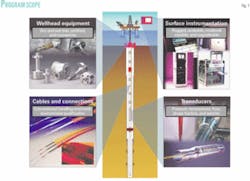New initiative to advance oil field automation
An initiative that aims to advance automation in certain types of oil and gas fields is Statoil AS’s subsea increased oil recovery (SIOR) program. A recent addition to this program involves the development of new fiber-optic-based sensing and communications systems to extend the life and substantially increase recovery from the company’s subsea oil and gas fields.
For this endeavor, Statoil has signed a 3-year technology development cooperation agreement with Weatherford International Ltd. The two companies will focus on both the development of new downhole optical sensing systems and an integrated fiber-optic subsea communication system for improving overall reservoir and production management
The agreement calls for field testing the system in both existing and new fields. Weatherford said, “the communication infrastructure will enable Statoil to implement an entire range of new solutions that require a high and secure bandwidth.”
Weatherford has agreements with both FMC Kongsberg Subsea and Nexans Norway AS to work with them on the communications system.
Oil field automation
The industry’s move towards a digital or intelligent oil field requires a diverse range of technologies depending on the operational requirements of specific oil or gas fields. Various technologies are available already for controlling and measuring flow as well as sensing various operating parameters in real time. Most of these devices rely on electric lines for transmitting signals, but also in the last decade fiber optics has found various niches.
Weatherford claims that to date it has run in wells more than 1 million ft of fiber-optic cable or 3 million ft of optic fiber.
Key advantages of fiber optics over the more traditional downhole electrical monitoring systems, according to the company, are:
- Being inherently more reliable due no downhole electronics.
- Allowing placement of multiple sensors and sensor types on a single fiber, thereby reducing the number of penetrations required in the subsea tubing hanger-a key issue in subsea applications.
- Having ability to operate reliably in higher temperature wells.
Brian Drakeley, fiber optics R&D coordinator for Weatherford (and also coproject manager for this new initiative along with Svein Omdal of Statoil), said electronic devices currently have a 150° C. (302° F.) performance barrier, while Weatherford fiber optic sensors are rated for operating temperatures in excess of 175° C. (347° F.). He added that requirements for higher operating temperatures are being evaluated.
Some of Wetherford’s existing in-well optical sensors include:
- Pressure and temperature transducers for single-point measurements.
- Distributed temperature sensing (DTS) in which the entire fiber length acts as the sensor.
- Array temperature sensing (ATS) that integrates an array of discrete optical temperature sensors.
- Optical flowmeters for providing single and multiphase flow measurements to and from different zones or laterals.
- Optical seismic accelerometers for such applications as time-lapsed vertical seismic profiling, crosswell seismic imaging, correlations with surface seismic, and passive microseismic monitoring.
Statoil’s program will develop other optical sensors with new capabilities.
New program
Statoil’s program (Fig. 1) with Weatherford includes new in-well optical sensors for:
- Sand monitoring that will identify and quantify sand production.
- Multiphase flow metering that will include a fiber-optic pressure differential sensor for three-phase flow measurements with restricted vertical separation. The work will also include refinement of the analysis tools.
- New applications of the fiber optic distributed and array temperature sensors such as for gas-lift valve leak detection.
- Evaluation of additional distributed sensing techniques.
The program also includes improving the cable and instrument durability in the marine environment.
Development of new subsea control, communications, and transmissions systems is another goal. Weatherford says that the system design will be based on fiber-optic open architecture and high-speed data communication. It will require new routers, switches, subsea cables, terminations, amplifiers, optical management, and high-speed data communication with an ethernet interface.
The system also will be integrated for subsea multiplexing and routing of optical signals as well as for interfacing with Statoil’s other projects.
The fully integrated fiber optical system is a new model for subsea surveillance and control, said Svein Omdal of Statoil.
“This is an exciting project,” he added, “and will allow us to deploy an entirely new communications infrastructure providing data anywhere on a Statoil network, safely and reliably from an automated monitoring system encompassing the reservoir, well production as well as the entire subsea infrastructure-all by fiber optics. All functionality will be integrated into one system to reduce complexity, reduce cost, and increase reliability.”
